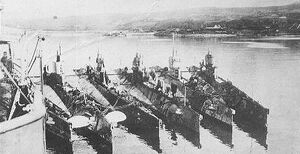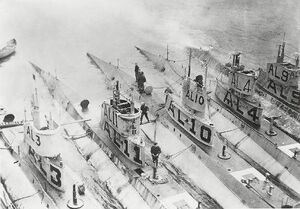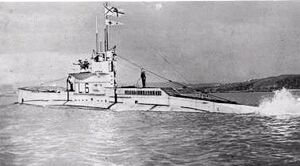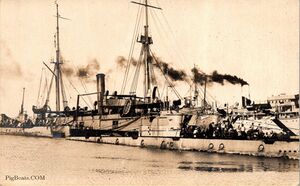General L-boat photos: Difference between revisions
Pbcjohnston (talk | contribs) mNo edit summary |
Pbcjohnston (talk | contribs) No edit summary |
||
| Line 37: | Line 37: | ||
After the boats arrived in the war zone in Ireland, the USN found that the British Royal Navy was also operating submarines in the area that were coincidentally called the L-class. Wanting to avoid problems in visually identifying the two classes of similarly named boats, the USN added the letter “A” to the side of the conning tower fairwater to the left of the letter “L”. This gave all friendly navies in the area the ability to quickly distinguish between the two classes. Contrary to popular belief, the boats WERE NOT officially renamed AL-3, AL-10, etc. on the Navy List or in any official Navy documents. They retained their original names and hull numbers for the duration of their service lives. The A’s were added when they arrived in the war zone and removed shortly after the conclusion of the war and the boat’s return to the states. It was a temporary visual expedient and nothing more. As an example, this boat is the HMS L6. | After the boats arrived in the war zone in Ireland, the USN found that the British Royal Navy was also operating submarines in the area that were coincidentally called the L-class. Wanting to avoid problems in visually identifying the two classes of similarly named boats, the USN added the letter “A” to the side of the conning tower fairwater to the left of the letter “L”. This gave all friendly navies in the area the ability to quickly distinguish between the two classes. Contrary to popular belief, the boats WERE NOT officially renamed AL-3, AL-10, etc. on the Navy List or in any official Navy documents. They retained their original names and hull numbers for the duration of their service lives. The A’s were added when they arrived in the war zone and removed shortly after the conclusion of the war and the boat’s return to the states. It was a temporary visual expedient and nothing more. As an example, this boat is the HMS L6. | ||
[[File:Alert w L-boats CZ-1.jpg|left|thumb|Photo courtesy David Wright, Navsource, Destroyer Archives Manager, Yard & District Archives Manager.]] | [[File:Alert w L-boats CZ-1.jpg|left|thumb|Photo courtesy David Wright, Navsource, Destroyer Archives Manager, Yard & District Archives Manager.]] | ||
This photo shows four L-class submarines alongside the submarine tenders Alert (AS-4) and Beaver (AS-5) at Naval Station Coco Solo, C.Z. on 24 December 1918. These boats were the Simon Lake designed variant of the L-class, distinguishable from their Electric Boat design sisters by the raised bows, large conning tower fairwaters, and the round flood ports for the watertight superstructure along their sides. Which boats are which are not known, but L-5, L-6, L-7, and L-8 were all sent to the Pacific immediately at the end of WWI and were homeported at San Pedro (Los Angeles) CA. They were known to have passed through the canal at Christmas time 1918 during their long journey to San Pedro and would have stopped in Coco Solo on the Atlantic side of the canal for a fueling and repair stop. The Alert is the darker colored ship closest to the submarines. The Beaver is the ship further away, with the “dazzle” camouflage paint scheme. There is a hand-written note on the back of the photo that says "L boats and USS Alert after landing, day before Xmas in Coco Solo C.Z.", meaning that this was the day they arrived in Coco Solo. | This photo shows four L-class submarines alongside the submarine tenders Alert (AS-4) and Beaver (AS-5) at Naval Station Coco Solo, C.Z. on 24 December 1918. These boats were the Simon Lake designed variant of the L-class, distinguishable from their Electric Boat design sisters by the raised bows, large conning tower fairwaters, and the round flood ports for the watertight superstructure along their sides. Which boats are which are not known, but L-5, L-6, L-7, and L-8 were all sent to the Pacific immediately at the end of WWI and were homeported at San Pedro (Los Angeles) CA. They were known to have passed through the canal at Christmas time 1918 during their long journey to San Pedro and would have stopped in Coco Solo on the Atlantic side of the canal for a fueling and repair stop. The Alert is the darker colored ship closest to the submarines. The Beaver is the ship further away, with the “dazzle” camouflage paint scheme. There is a hand-written note on the back of the photo that says "L boats and USS Alert after landing, day before Xmas in Coco Solo C.Z.", meaning that this was the day they arrived in Coco Solo. | ||
Revision as of 16:19, 14 April 2023

A small photo of three L-boats at an unknown location, probably in the spring or summer of 1916. This is definitely a pre-WWI photo, as these boats do not have the installed "chariot" style bridge structures.

Six L-class boats moored outboard of their tender in Queenstown, Ireland, summer of 1918. Left to right is L-3, L-11 (with bow planes rigged out), L-10, L-4, L-9, and L-2.

A slightly later photo than the one above, taken in the late summer of 1918 in Queenstown, Ireland. L-3, L-11, L-10, L-4, and the L-5. An accumulation of war experience is evident in this photo, as the boats have had the semi-permanent "chariot" style bridge structures added. The structure on L-10 seems rather small, and it is possible that she has yet to receive the larger structure. The letter A added to their names was a temporary expedient that was carried only while the boats were in theater in Europe. They were removed almost immediately after their return to the States. The post like object sticking up above the deck forward of the conning tower fairwater is the retracted 3"/23 caliber Mk 9 deck gun.

After the boats arrived in the war zone in Ireland, the USN found that the British Royal Navy was also operating submarines in the area that were coincidentally called the L-class. Wanting to avoid problems in visually identifying the two classes of similarly named boats, the USN added the letter “A” to the side of the conning tower fairwater to the left of the letter “L”. This gave all friendly navies in the area the ability to quickly distinguish between the two classes. Contrary to popular belief, the boats WERE NOT officially renamed AL-3, AL-10, etc. on the Navy List or in any official Navy documents. They retained their original names and hull numbers for the duration of their service lives. The A’s were added when they arrived in the war zone and removed shortly after the conclusion of the war and the boat’s return to the states. It was a temporary visual expedient and nothing more. As an example, this boat is the HMS L6.

This photo shows four L-class submarines alongside the submarine tenders Alert (AS-4) and Beaver (AS-5) at Naval Station Coco Solo, C.Z. on 24 December 1918. These boats were the Simon Lake designed variant of the L-class, distinguishable from their Electric Boat design sisters by the raised bows, large conning tower fairwaters, and the round flood ports for the watertight superstructure along their sides. Which boats are which are not known, but L-5, L-6, L-7, and L-8 were all sent to the Pacific immediately at the end of WWI and were homeported at San Pedro (Los Angeles) CA. They were known to have passed through the canal at Christmas time 1918 during their long journey to San Pedro and would have stopped in Coco Solo on the Atlantic side of the canal for a fueling and repair stop. The Alert is the darker colored ship closest to the submarines. The Beaver is the ship further away, with the “dazzle” camouflage paint scheme. There is a hand-written note on the back of the photo that says "L boats and USS Alert after landing, day before Xmas in Coco Solo C.Z.", meaning that this was the day they arrived in Coco Solo.